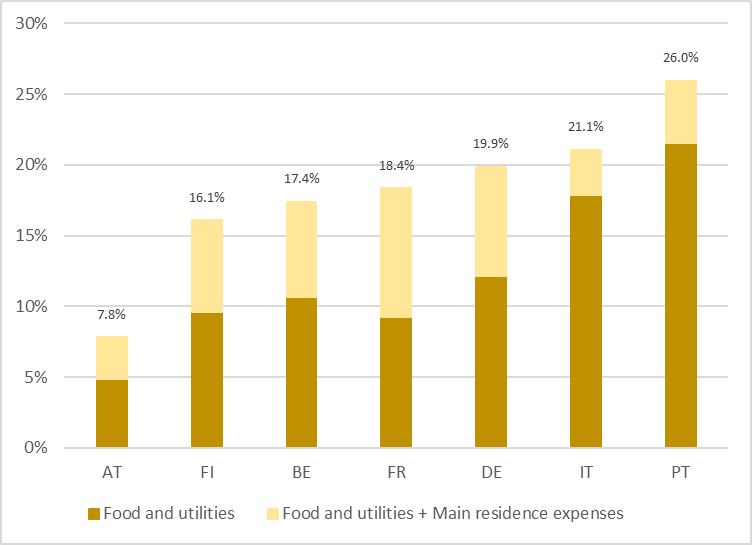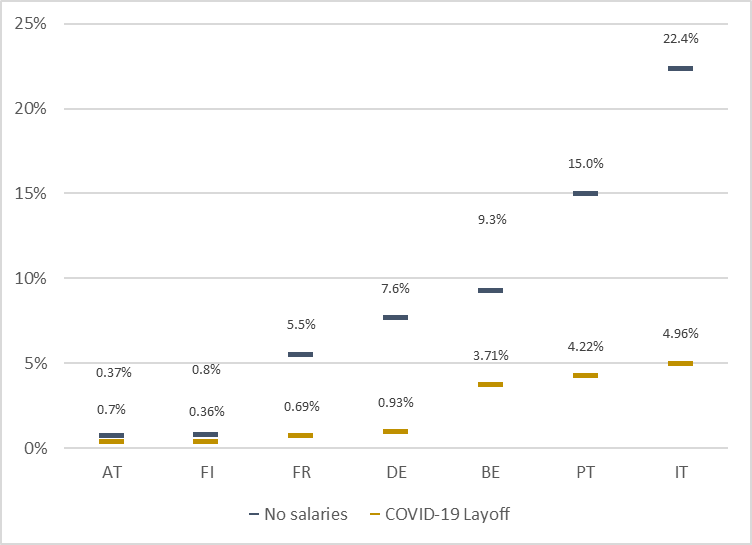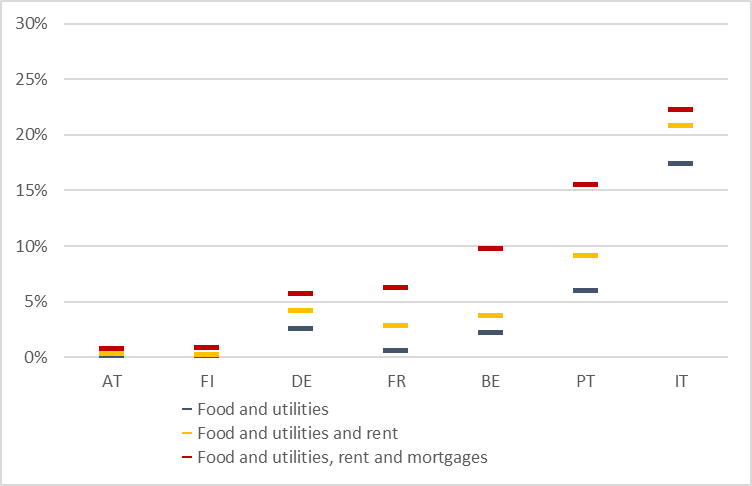The COVID-19 outbreak has brought, alongside a major health crisis, dramatic economic shocks to European countries. Governments around the continent are taking different measures to face the pandemic while preserving jobs and incomes (Baldwin and Weder di Mauro 2020). With economic activity far below pre-pandemic levels, many households are still witnessing substantial decreases in their earnings (Adams-Prassl et al, 2020).
In a recent paper (Midoes and Seré 2021), we analyse households’ financial vulnerabilities to an income shock and assesses the degree of protection awarded to employees, in different European countries, by COVID-19 employment protection schemes. The literature has measured financial vulnerability with different approaches, such as possession of financial assets, amounts in savings accounts and access to credit, or by directly asking individuals how confident they are that they could come up with a certain amount of money to face an unexpected need (Lusardi et al. 2011).
In our work, we instead define households as financially vulnerable or not by assessing whether they could cover their usual basic expenditures under a hypothetical shock. For that we analyse whether they could afford food and utilities, rent and mortgages if deprived of their privately earned income,1 resorting instead to a combination of savings and publicly provided income such as pensions, public transfers first, and also COVID-19 unemployment protection.
Our data come from Wave 3 of the ECB Household Finance and Consumption Survey (HFCS), conducted in 2017 where we consider seven countries (Austria, Belgium, Finland, France, Germany, Italy and Portugal). Given that the HFCS only covers gross income, we simulate net incomes obtained under the actual COVID-19 unemployment protection schemes enacted by each country through a microsimulation model, EUROMOD.2 Table 1 in the annex provides details on the COVID-19 unemployment benefits simulate
Vulnerability without unemployment protection schemes
For the seven countries of our sample, we estimate that 31.2 million individuals – or 12.8% of their combined population – are financially vulnerable when we consider food and utilities over a three-month horizon, meaning that they would not be able to afford those expenses for three months without privately earned income.3
As Figure 1 shows, both rent and mortgage expenses substantially increase the number of vulnerable individuals. Without privately earned income, 47.2 million, or 19.4% of the population analysed, cannot afford expenses once we add rents and mortgages to their basket. In relative terms, the impact of housing expenses is more severe in countries such as Germany and France – in the former, the percentage of vulnerable individuals jumps from 12.2% to 19.9%; in the latter it doubles from 9.2% to 18.4% - than in Portugal or Italy.
Figure 1 Percentage of vulnerable individuals at a three-month horizon when rent and mortgages are added to basket
Vulnerability under COVID-19 unemployment benefits
By restricting our sample to households where at least one individual has been in employment throughout the previous year, we consider whether households can afford expenses when they are deprived of their salary but are instead receiving COVID-19 unemployment benefits.4
We find that, considering food and utilities only, at the three-month mark the situation is not too dire overall – only 5.9% of affected individuals are vulnerable at this point. As Figure 2 shows, this number hides important country differences – in Italy, 17% of affected individuals are vulnerable. For all countries the situation improves substantially when we add COVID-19 benefits. In Italy, there is a drastic reduction to only 1.13% of vulnerable individuals. While we estimate that 9.6 million people in the countries considered could not afford food and utilities, only 1.7 million would not be able to do so once COVID-19 unemployment benefits are awarded.
Figure 2 Percentage of vulnerable individuals with and without COVID-19 layoff, at a three month-horizon, considering food and utilities
When we consider rent and mortgage as part of basic expenses, the percentage of vulnerable individuals increases to 10.5%. Nonetheless, COVID-19 employment protection benefits reduce the percentage of vulnerable individuals to 2.1%. As Figure 3 shows, the benefits are again quite effective at reducing vulnerabilities across all countries. In Italy, Portugal and Belgium, where vulnerability is highest at baseline, we estimate only 5.0%, 4.2% and 3.7%, respectively, of those affected are vulnerable at the three-month mark. Despite the effectiveness of the scheme, Italy is the country with the highest absolute number of vulnerable individuals, at 969,000. France, where only 0.85% of those affected are vulnerable, nonetheless follows with 360,000.
Figure 3 Percentage of vulnerable individuals with and without COVID-19 layoff, at a three-month horizon, considering food and utilities and rent and mortgages on the main residence
Policy discussion
Effects of a more generous COVID-19 unemployment benefit
With the exception of Finland – where the unemployment benefit is a daily fixed amount – the unemployment scheme covers a percentage of salaries, varying from 60% (in Portugal) to 90% (in Austria). By raising the replacement rate to 90%, we observe a reduction of individuals’ vulnerability in all countries. A more noticeable effect is observed in Italy and Portugal, but there are also meaningful reductions in countries with an already extremely low percentage of vulnerable individuals (i.e. in France, Finland and Belgium).
This highlights the fact that the vulnerable individuals identified in our simulations do not come from gaps in coverage generated by our procedure, but from the coverage itself not being sufficient for expenses. The results we now find, where there is an important reduction of vulnerability under a more generous layoff scheme, are a reflection of this. It should be noted that while the performance of Belgium was among the best before considering COVID-19 unemployment benefits, after its consideration, the country only performs better than Italy and Portugal. This is because the Belgian COVID-19 income support is amongst the least generous.
Figure 4 Percentage of vulnerable individuals with the current COVID-19 layoff and with a replacement rate of 90% of salaries, at a three-month horizon, considering food and utilities and housing expenses
Effect of a suspension of rent and mortgages on the main household
In Figure 5a we can see the percentage of vulnerable individuals when we consider expenses on food and utilities, rent and mortgage, at the three-month mark, detailing how much each expense contributes to overall vulnerability. In Germany and Italy, expenses with rent explain a larger part of vulnerability than mortgages. For example, in Italy, the percentage of individuals who would not be able to cover expenses considering food and utilities, rent, and mortgages is 22.3%. This percentage would be reduced by 3.4 percentage points if a rent suspension were enacted. By contrast, it would only be reduced by 1.5 percentage points if instead mortgages were suspended. We observe the opposite in countries such as Belgium and Portugal. In these countries, while rent suspension would only reduce the percentage of vulnerable individuals by 1.6 percentage points and 3.1 percentage points, respectively, mortgages suspension would reduce it by 6 percentage points and 6.4 percentage points, respectively.
When we analyse these policies under a scenario where individuals are receiving the COVID-19 layoff (Figure 5b), in Portugal, rent and mortgage expenditures play a similar role, in Italy rent remains more relevant, and in Belgium mortgages remain more relevant. Rent and mortgage suspensions thus can be an effective support for vulnerable households. In most countries, both under a non-salary scenario and under COVID-19 benefits, mortgages play a more relevant role. Yet, in Italy, rent is more relevant, while in France, they are equally important. This highlights the need to develop country-specific policies for alleviating vulnerability.
Figure 5a Percentage of vulnerable individuals without COVID-19 layoff, at a three-month horizon, considering food and utilities and housing expenses (by component)
Figure 5b Percentage of vulnerable individuals with COVID-19 layoff, at a three-month horizon, considering food and utilities and housing expenses (by component)
Concluding remarks
While we still do not know how long the economic recession induced by the COVID-19 pandemic will last, in this column we atempt to provide evidence on how sensitive individuals are to this type of shock and on the effectiveness of the enacted mitigation policies.
Even with pensions and public transfers, a large number of individuals depend on household privately earned income to cover for their most basic expenses in the very short term – 18.2 million individuals, or 7% of the population of the seven European countries analysed, cannot cover one month of food and utilities by resorting to their deposits, pensions and public transfers. At the three-month horizon, this number increases to 31.2 million, or 13% of the population analysed. We observe a significant drop in the number of vulnerable people when we award them COVID-19 unemployment benefits. By considering net incomes on households of employees, we find significant differences across countries. Employees in Austria, Finland, Belgium and Germany are less vulnerable to a labour income shock than those in Italy and Portugal. The employment protection schemes awarded are extremely effective in decreasing these numbers, particularly in Italy. Rent and mortgage suspensions are more effective in some countries than in others. Countries like Portugal, Belgium and France can achieve an important reduction in their vulnerability through these measures, while in Italy they should be coupled with COVID-19 unemployment benefits to bring about a meaningful reduction.
Two reasons explain why countries like Austria and France perform better than, for example, Portugal. The first is that, in the former two countries, only 2.1% and 2.5%, respectively, receive an income below basic expenses under the scheme, while in Portugal that figure is 12.7%. The difference in the generosity of the support results in a more effective public transfer in the former two countries, just as with non-COVID-19 public transfers. The second reason is the pre-existing differential in savings – French and particularly Austrian households can cover their expenses from deposits alone for a longer period of time.
Countries with wider fiscal space can enact more generous policies. The layoff schemes in Austria and Finland are more generous than the Portuguese. Households in these countries, according to our results, are the most robust to overall income shocks, being able to sustain expenses from deposits alone for longest. These differentials in suffered impact, household finances, and public finances underlie the different perceptions of urgency about the crisis and different eagerness for concerted EU financing of support policies.
References
Adams-Prassi, A, T Boneva, M Golin and C Rauh (2020), “The large and unequal impact of COVID-19 on workers”, VoxEU.org, 8 April.
Anderson, J, E Bergamini, S Brekelmans, A Cameron, Z Darvas, M Domínguez Jíménez and C Midões (2020), “The fiscal response to the economic fallout from the coronavirus”, Bruegel Datasets, last update 6 May.
Baldwin, R, and B Weder di Mauro (eds.) (2020), Mitigating the COVID economic crisis: Act fast and do whatever it takes, VoxEU.org eBook, CEPR.
European Commission (2020). “Policy measures taken against the spread and impact of the coronavirus”.
Kuypers, Sarah et al. (2017). “EWIGE-European Wealth data Integration in EUROMOD”. Tech. rep. JRC Working Papers on Taxation and Structural Reforms.
Midoes, C and Seré, M (2021), “Living with reduced income: an analysis of the household financial vulnerability under COVID-19”. COVID Economics 63.
Sutherland, Holly (2001), EUROMOD: An integrated European benefit-tax model. Tech. rep. EUROMOD Working Paper.
Annex
Table 1 Additional details on the COVID-19 unemployment benefits simulated
Sources: Anderson et al. (2020) and European Commission (2020).
Endnotes
1 By privately earned income, we mean income other than pensions and public transfers. It encompasses salary income, self-employed income, rental income, income from financial assets and regular private transfers.
2 EUROMOD is a static model that calculates country-specific social insurance contributions, income taxation and means-tested cash benefits to obtain market incomes. It simulates cash benefit entitlements and direct tax and social insurance contribution liabilities, on the basis of the tax-benefit rules in place and information available in the underlying datasets (see Sutherland (2001) and Kuypers et al. (2017)).
3 For food expenses we consider average monthly expenditure on food and beverages at home. Utility expenses comprise average monthly expenditure on utilities, specifically electricity, water, gas, TV and internet.
4 It should be noted that besides applying income taxation, in the scenario where individuals are not receiving salaries, they also receive means-tested social benefits to which they would be entitled under reduced income.










